Marne la Vallée, France – Tuesday, March 23rd, 2010
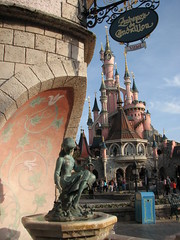 Three days at Disney was probably overdoing it. By comparison, I only allotted myself one full day to see Paris, and yet for some reason I felt three would be needed to fully see Disney. That is not an itinerary one should admit to other people when they ask about how you’ll be allocating your time during your four days in Paris. Now to justify this slightly, originally I had been planning to only see Disneyland over a three-day weekend and not even step foot inside the city, which I wanted to save for another time (i.e. when Parc Astérix and Parc Saint Paul would be open). Then plans changed and after deciding I needed to buy my tickets at the Disney Store on the Champs-Élysées for the best discount and that I could make a stop to try out Jardin d’Acclimatation’s three coasters, I said, “alright, I’ll spend a day in Paris, too.” Just to get a taste of the city to motivate me even more to return one day. Meanwhile Disney I wanted to make sure I would have ample time to explore every nook and cranny and get so many re-rides on the coasters until I was sick of them that I would thereafter have absolutely no motivation to ever return ever again. But still, three days at Disney was probably overdoing it…
Three days at Disney was probably overdoing it. By comparison, I only allotted myself one full day to see Paris, and yet for some reason I felt three would be needed to fully see Disney. That is not an itinerary one should admit to other people when they ask about how you’ll be allocating your time during your four days in Paris. Now to justify this slightly, originally I had been planning to only see Disneyland over a three-day weekend and not even step foot inside the city, which I wanted to save for another time (i.e. when Parc Astérix and Parc Saint Paul would be open). Then plans changed and after deciding I needed to buy my tickets at the Disney Store on the Champs-Élysées for the best discount and that I could make a stop to try out Jardin d’Acclimatation’s three coasters, I said, “alright, I’ll spend a day in Paris, too.” Just to get a taste of the city to motivate me even more to return one day. Meanwhile Disney I wanted to make sure I would have ample time to explore every nook and cranny and get so many re-rides on the coasters until I was sick of them that I would thereafter have absolutely no motivation to ever return ever again. But still, three days at Disney was probably overdoing it…
 After wrapping up a brief two hours spent in the Walt Disney Studios Park getting caught up on some of the things I missed out on the day prior, I made my way to the entrance of Disneyland by noon. I quickly found the fastest route to the Big Thunder Mountain fast pass ticket dispensers, and then hopped
After wrapping up a brief two hours spent in the Walt Disney Studios Park getting caught up on some of the things I missed out on the day prior, I made my way to the entrance of Disneyland by noon. I quickly found the fastest route to the Big Thunder Mountain fast pass ticket dispensers, and then hopped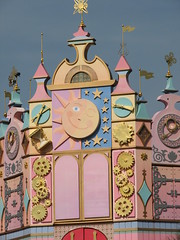 aboard the Disneyland Railroad from the Frontierland depot to take me back to Fantasyland to kill the time before my fast pass return time was ready. There was still one major dark ride in the park I had not been on the first day and it was located in Fantasyland. Let me check my park guide to see what it could be… it’s not the Snow White or Pinocchio rides, although those need to be done as well. Already did Peter Pan two days ago, which leaves me with… oh, dear God, no. The Happiest Ride on Earth, “it’s a small world”.
aboard the Disneyland Railroad from the Frontierland depot to take me back to Fantasyland to kill the time before my fast pass return time was ready. There was still one major dark ride in the park I had not been on the first day and it was located in Fantasyland. Let me check my park guide to see what it could be… it’s not the Snow White or Pinocchio rides, although those need to be done as well. Already did Peter Pan two days ago, which leaves me with… oh, dear God, no. The Happiest Ride on Earth, “it’s a small world”.
It’s not just the song, which repeats the same chords over and over and over and won’t leave your head afterward no matter what you try. It’s not just the sets, which for ten minutes you float by the same candy-colored scenes of multi-ethnic children joined in song. It’s the fact that the whole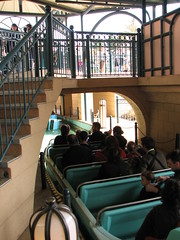 thing feels so… innocently happy. To put this in perspective, my idea of a good time in the recent past has included attending a double feature of The Road and Antichrist, in which the first movie set in the post-apocalyptic world about a father and son resisting the urge to become cannibals like everyone else in the country as they futilely search for safety was, to me, the cheerful, uplifting film between the two. This has just always been a ‘thing’ with me; that is, I hear people say “oh, such-and-such movie or book was good but it’s also really depressing, I’d rather have one that lifts my spirits up and makes me feel happy at the end,” I don’t know how to reply because for me it’s the opposite. ‘Happy’ stories are inherently depressing because the narrative manipulations only highlight the fictional nature of the experience in contrast with real life; meanwhile those that other people label as depressing I would label as exhilarating simply because I’ve been in the presence of great art. If it’s ‘depressing’ and a bad work of art, then why should I feel depressed by it when all I should be is sharply critical of its faults. Hopefully that explains where I’m coming from when I stepped onto the boat of “it’s a small world”
thing feels so… innocently happy. To put this in perspective, my idea of a good time in the recent past has included attending a double feature of The Road and Antichrist, in which the first movie set in the post-apocalyptic world about a father and son resisting the urge to become cannibals like everyone else in the country as they futilely search for safety was, to me, the cheerful, uplifting film between the two. This has just always been a ‘thing’ with me; that is, I hear people say “oh, such-and-such movie or book was good but it’s also really depressing, I’d rather have one that lifts my spirits up and makes me feel happy at the end,” I don’t know how to reply because for me it’s the opposite. ‘Happy’ stories are inherently depressing because the narrative manipulations only highlight the fictional nature of the experience in contrast with real life; meanwhile those that other people label as depressing I would label as exhilarating simply because I’ve been in the presence of great art. If it’s ‘depressing’ and a bad work of art, then why should I feel depressed by it when all I should be is sharply critical of its faults. Hopefully that explains where I’m coming from when I stepped onto the boat of “it’s a small world”
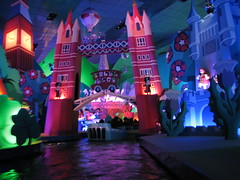 But okay, so it’s a ride that celebrates the economic push for globalization that robs nations of their political sovereignty while promoting superficial cultural differences that should exist only as a novelty for the industrialized western world to gawk at. That seems like a perfect fit for Disney. And actually for what it’s worth I did not regret the experience at all, although perhaps for not the right reasons. Technically there’s some pretty interesting stuff in there, and so I spent most of the ride snapping pictures and marveling over the sheer amount of labor hours that must have gone into building each of these sets. Pleasing colors, well-proportioned sets, perfectly blocked animatronics… it could have been an attraction showcasing the wonderful world of tort reform and it wouldn’t have made any difference just as long as the sets were designed
But okay, so it’s a ride that celebrates the economic push for globalization that robs nations of their political sovereignty while promoting superficial cultural differences that should exist only as a novelty for the industrialized western world to gawk at. That seems like a perfect fit for Disney. And actually for what it’s worth I did not regret the experience at all, although perhaps for not the right reasons. Technically there’s some pretty interesting stuff in there, and so I spent most of the ride snapping pictures and marveling over the sheer amount of labor hours that must have gone into building each of these sets. Pleasing colors, well-proportioned sets, perfectly blocked animatronics… it could have been an attraction showcasing the wonderful world of tort reform and it wouldn’t have made any difference just as long as the sets were designed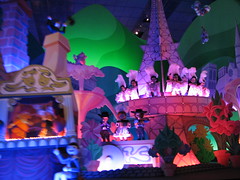 with the same level of care and precision. That’s the thing I’ve found out about Disney, most of the time it doesn’t even matter what the subject material is, the spectacle is simply being immersed in the presence of such an overwhelming display of technical craft (or, at the very least, an impressive capital budget) that all other concerns seem to float out the door.
with the same level of care and precision. That’s the thing I’ve found out about Disney, most of the time it doesn’t even matter what the subject material is, the spectacle is simply being immersed in the presence of such an overwhelming display of technical craft (or, at the very least, an impressive capital budget) that all other concerns seem to float out the door.
So did I enjoy “it’s a small world”? Let the fact that despite a less than 10 minutes queue I only rode it once during my entire stay at Disney speak for itself. My immediate repulsion towards the concept of the attraction did make me stop for a moment to consider what does seem to be a rather odd sociological trend. Consider an individual who is always happy.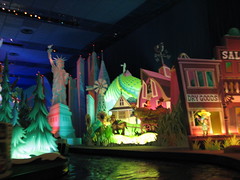 No matter the circumstances, they always come to work with a smile on their face and song in their heart, and whose only unrequited desire is the ability to lift the spirits of coworkers who have the misfortune of lacking the same quantities of mirth as themselves have the good fortune to be bestowed with. If you’re like most adults, your impression of this individual will not be, “what a kind, strong-willed personality; I wish I could always be as happy as they!” Your impression will be to keep as far away from this individual as possible, and perhaps to even wish some ill-fortune to befall them in order for the sake of everyone else around them to stop acting so silly and start behaving like a real human being, with the proper amounts of depression, doubt and self-loathing that should always entail. And there you have the reaction to “it’s a small world”.
No matter the circumstances, they always come to work with a smile on their face and song in their heart, and whose only unrequited desire is the ability to lift the spirits of coworkers who have the misfortune of lacking the same quantities of mirth as themselves have the good fortune to be bestowed with. If you’re like most adults, your impression of this individual will not be, “what a kind, strong-willed personality; I wish I could always be as happy as they!” Your impression will be to keep as far away from this individual as possible, and perhaps to even wish some ill-fortune to befall them in order for the sake of everyone else around them to stop acting so silly and start behaving like a real human being, with the proper amounts of depression, doubt and self-loathing that should always entail. And there you have the reaction to “it’s a small world”.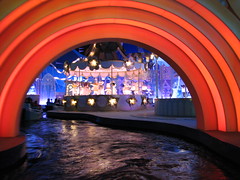
Where does this attitude come from? Is it just a general hatred of happiness in many of us? It seems the repulsion to anything in a perpetual state of cheer is automatic and unquestioned, suggesting it may stem from cultural conditioning. Perhaps the percentage of the population suffering from anhedonia collectively decided to make it appear ‘cool’ to hate on anyone displaying needless happiness, and so snark and sarcasm became the new dominant forms of humor in mass media rather than good old-fashioned song-and-dance and knock-knock jokes. Or perhaps there is legitimacy to this prevailing skepticism against happiness. For most of the corporate world the concept of ‘happiness’ has been objectified into a consumer product ready to be packaged, marketed and sold to the general public, with Disney most likely being at the forefront of this campaign. It’s nothing against happiness in and of itself, but the sentiment is that real happiness has to be earned; a severely handicapped person who finds picking up and dropping leaves to be the greatest fulfillment in the world may in fact be the happiest person alive, but we would almost never say that this person is leading the ideal of a ‘good life’. When I see joy and celebration simply floating around with no apparent reason, I find there is something greatly suspect about that, and it therefore rides such as “it’s a small world” become a target of derision in order to see if any holes can be poked through the joyful façade to discover what underlying machinations exist.
marketed and sold to the general public, with Disney most likely being at the forefront of this campaign. It’s nothing against happiness in and of itself, but the sentiment is that real happiness has to be earned; a severely handicapped person who finds picking up and dropping leaves to be the greatest fulfillment in the world may in fact be the happiest person alive, but we would almost never say that this person is leading the ideal of a ‘good life’. When I see joy and celebration simply floating around with no apparent reason, I find there is something greatly suspect about that, and it therefore rides such as “it’s a small world” become a target of derision in order to see if any holes can be poked through the joyful façade to discover what underlying machinations exist.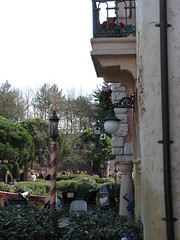
After “it’s a small world” I still had a bit more time until my Big Thunder Mountain fast pass was ready so I made a stop at the Fantasia Gelati to pick up a snack to tide me over until later in the day. The map was indicating that this was the only food location in the entire park that served crêpes, and seeing as I skipped ordering one during my one day in the city, it seemed it would be a great injustice for myself to leave France without having tried a crêpe. I only mention this because here’s where I easily had my worst customer service experience while at Disney: staffed by only one employee who had clearly already become too disillusioned with the futility of his task that he made no effort to hurry, I had at least a twenty minute wait for what ended up being a €3 soggy, extra thin pancake that was barely able to fill the size of the smallest diameter Dixie paper plate they served it on. I didn’t even get to enjoy a moment’s rest on a shaded table because by the time I finally was served I needed to make haste over to Big Thunder Mountain so I could pick up my next fast pass.
It was soon determined that after experiencing “it’s a small world” I needed a dark ride with hair on it, one that wasn’t themed to a celebration of singing children and world peace, but rather a celebration of looting, arson and rape. Thankfully Disney has an answer to my needs not far away in the form of Pirates of the Caribbean.
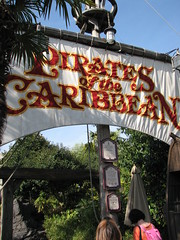 The queue for this was one of the longer ones between both days I was there but it moved fast enough (as is the case with most Disney attractions) and is also one of the better places to spend waiting in line. After a small outdoor switchback section we’re channeled into the Caribbean stone castle, winding our way through some dark corridors with an occasional display chamber featuring the skeletal remains of inmates. Near the terminus of the queue is the final loading platform showroom, and this represented one of the couple of places in the park in which I could truly understand why Disney attracts such a rabid fanbase. You know how in dark rides that are supposed to have night scenes the lighting technicians always get too proud and decide to put show lighting in every single corner of the room, resulting in too bright of a setting while also illuminating all the wiring and prop backings that are not supposed to be seen? That is not the case with this room, which uses just enough yellow and red lighting exclusively from the lanterns set along the pathway to create an exotic glow against the stonework walls and tropical foliage, while not enough to reach to the ceiling, which my eyes were telling me was a authentic starry night sky and not just a ceiling
The queue for this was one of the longer ones between both days I was there but it moved fast enough (as is the case with most Disney attractions) and is also one of the better places to spend waiting in line. After a small outdoor switchback section we’re channeled into the Caribbean stone castle, winding our way through some dark corridors with an occasional display chamber featuring the skeletal remains of inmates. Near the terminus of the queue is the final loading platform showroom, and this represented one of the couple of places in the park in which I could truly understand why Disney attracts such a rabid fanbase. You know how in dark rides that are supposed to have night scenes the lighting technicians always get too proud and decide to put show lighting in every single corner of the room, resulting in too bright of a setting while also illuminating all the wiring and prop backings that are not supposed to be seen? That is not the case with this room, which uses just enough yellow and red lighting exclusively from the lanterns set along the pathway to create an exotic glow against the stonework walls and tropical foliage, while not enough to reach to the ceiling, which my eyes were telling me was a authentic starry night sky and not just a ceiling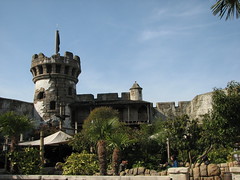 painted black and with small LED lights implanted into it. (After enough time had elapsed and my eyes adjusted from the outdoor brightness to this low-light interior I could see the outlines of some ventilation units next to Ursa Major.) The humidity and that aroma of running water from the nearby flume channel (I know water is technically odorless but hopefully you kind of know what I’m talking about) contribute to the creation of what many themed attractions seem to be sorely missing: atmosphere. Yes, for a few moments in that showroom I felt as though I really could have been transported to a different time and place, and without an overload of different props and effects whizzing around my head as on Phantom Manor I was able to simply take it all in. And now we board the boats.
painted black and with small LED lights implanted into it. (After enough time had elapsed and my eyes adjusted from the outdoor brightness to this low-light interior I could see the outlines of some ventilation units next to Ursa Major.) The humidity and that aroma of running water from the nearby flume channel (I know water is technically odorless but hopefully you kind of know what I’m talking about) contribute to the creation of what many themed attractions seem to be sorely missing: atmosphere. Yes, for a few moments in that showroom I felt as though I really could have been transported to a different time and place, and without an overload of different props and effects whizzing around my head as on Phantom Manor I was able to simply take it all in. And now we board the boats.
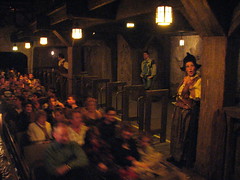 Out of the loading platform, the first part of the flume channel is mostly a quiet rainforest lagoon with waterfalls, no swashbuckling yet. A terrace for the Blue Lagoon restaurant is built inside this environment as well, and everyone on the boat sees this and thinks, “ah, I’d like to have dinner there tonight but it’s probably too expensive!” Past the waterfall we begin to climb upward while the famous Yo Ho theme song begins the fill in the background over the roar of rushing water. The adventure is about to begin.
Out of the loading platform, the first part of the flume channel is mostly a quiet rainforest lagoon with waterfalls, no swashbuckling yet. A terrace for the Blue Lagoon restaurant is built inside this environment as well, and everyone on the boat sees this and thinks, “ah, I’d like to have dinner there tonight but it’s probably too expensive!” Past the waterfall we begin to climb upward while the famous Yo Ho theme song begins the fill in the background over the roar of rushing water. The adventure is about to begin.
I am told by television theme park specials that what makes a Disney ride such as Pirates of the Caribbean so special is the fact that it’s not just a series of elaborate gags as you will find at other theme parks, but that huge amounts of time and energy are spent in making sure a story is told throughout the attraction. Once the bulk of the story’s action starts, as we float by I can imagine in my head the pitch originally made to sell this story to guests:
are spent in making sure a story is told throughout the attraction. Once the bulk of the story’s action starts, as we float by I can imagine in my head the pitch originally made to sell this story to guests:
“Okay, so there’s these pirates, right? But they’re not just any kind of pirate, they’re Caribbean pirates! And these pirates, you know, they’re making a mess of things. Pillaging. Plundering. The works. Now, I know what you’re thinking, ‘I’ve seen pillage and plunder before!’ Here’s the twist. You also have insobriety and attempted rape. Ah, bet you weren’t seeing those things coming! Now, you might be thinking to yourself, ‘okay, there’s the characters, but where’s the story?’ That’s coming, believe me, but first – and I think this is the thing that makes or breaks this whole idea,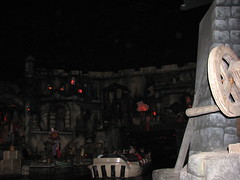 it’s not just something to have in there for laughs but is really the, uh, you-know – that’s having the audience come to understand and connect with the psychology of these characters first. I’m being really serious right now. Because, you know, these character can initiate events in the plot, but what does it matter if we don’t know why they had the need for such actions. So here’s that burning psychology summed up in four simple words: “A pirate’s life for me!” Five simple words. That doesn’t count the apostrophe since it’s a possessive. So, we have the characters and we have the motivation… do we have a girl? You betcha, several in fact! Alright, so now to answer the question, where’s the story? It’s, um, well, you know, I should tell you first off that it’s not really all about the story, you know, like with plot point A, B, climax, denouement,
it’s not just something to have in there for laughs but is really the, uh, you-know – that’s having the audience come to understand and connect with the psychology of these characters first. I’m being really serious right now. Because, you know, these character can initiate events in the plot, but what does it matter if we don’t know why they had the need for such actions. So here’s that burning psychology summed up in four simple words: “A pirate’s life for me!” Five simple words. That doesn’t count the apostrophe since it’s a possessive. So, we have the characters and we have the motivation… do we have a girl? You betcha, several in fact! Alright, so now to answer the question, where’s the story? It’s, um, well, you know, I should tell you first off that it’s not really all about the story, you know, like with plot point A, B, climax, denouement,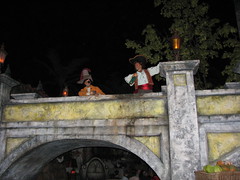 etc. That’s a very Hollywood way of storytelling, and I think our audience wants something a bit deeper than that. Pirates of the Caribbean, to me, is more of a character study, or just a kind of quiet, contemplative reflection on a certain state of humanity. In a way I would sort of liken it to being something akin to Yasujirô Ozu’s Floating Weeds. But with pirates. Anyway, I can see you’re starting to glaze, so I’ll wrap this up quick. They set a building on fire, and then everyone falls down a waterfall for some reason. Kids and adults love it, and then there’s the buried treasure discovered at the end to tie up any loose ends, the boat gets back to the station, people get off and go home, satisfied with how they spent their 8 bucks admission. So there you have it. End o’ pitch.”
etc. That’s a very Hollywood way of storytelling, and I think our audience wants something a bit deeper than that. Pirates of the Caribbean, to me, is more of a character study, or just a kind of quiet, contemplative reflection on a certain state of humanity. In a way I would sort of liken it to being something akin to Yasujirô Ozu’s Floating Weeds. But with pirates. Anyway, I can see you’re starting to glaze, so I’ll wrap this up quick. They set a building on fire, and then everyone falls down a waterfall for some reason. Kids and adults love it, and then there’s the buried treasure discovered at the end to tie up any loose ends, the boat gets back to the station, people get off and go home, satisfied with how they spent their 8 bucks admission. So there you have it. End o’ pitch.”
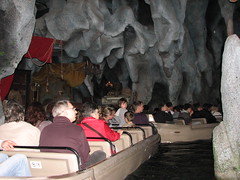 Was I satisfied? Wait, where was that story I had heard so much hype over? I counted many gags. Chasing wenchs on a turntable gags, cats on a floating barrel gags, dogs holding keys in its mouth gags, drunken bottle-tipping near my head in a way that reminds me of several college roommates I’ve had gags, but I had a hard time finding a story linked between all of those gags. To be sure, some are very expensive gags. Engineering two animatronics to sync a swordfight between the two left me feeling very satisfied that the money I put down on my admission ticket was being used for something. But in the end I sort of felt the question of “how can we showcase our technical animatronics skills” preceded that of “what sort of narrative/emotional experience do we want to provide our guests?” It’s not like this is the first and only P
Was I satisfied? Wait, where was that story I had heard so much hype over? I counted many gags. Chasing wenchs on a turntable gags, cats on a floating barrel gags, dogs holding keys in its mouth gags, drunken bottle-tipping near my head in a way that reminds me of several college roommates I’ve had gags, but I had a hard time finding a story linked between all of those gags. To be sure, some are very expensive gags. Engineering two animatronics to sync a swordfight between the two left me feeling very satisfied that the money I put down on my admission ticket was being used for something. But in the end I sort of felt the question of “how can we showcase our technical animatronics skills” preceded that of “what sort of narrative/emotional experience do we want to provide our guests?” It’s not like this is the first and only P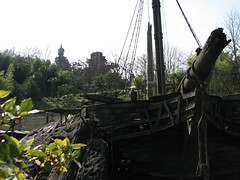 irates ride, so maybe I should try out the original California version which Walt Disney himself actually had a hand in before making any more judgments about the attraction myself.
irates ride, so maybe I should try out the original California version which Walt Disney himself actually had a hand in before making any more judgments about the attraction myself.
My first reaction was that Adventureland was the overlooked white elephant between all of Disneyland Paris’s themed lands. Checking the park guide for ride listings I discovered only two fully fledged mechanical rides in Adventureland, Pirates of the Caribbean and the Indiana Jones coaster, and the latter is of very dubious quality at least in terms of Disney’s standard of judgment. Everything else to me appeared to just be jungle-themed walkthroughs or interactive children’s exhibits, nothing that should have been of any real interest to park-goers in my demographics.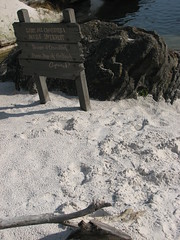 But after crossing by the area several times to get to Pirates or Indiana Jones, both of which are located on the far back edge of Adventureland, I came under the impression that there was an awful lot of land in between the main walkways, and I wasn’t altogether sure what was contained within it. So I decided to explore.
But after crossing by the area several times to get to Pirates or Indiana Jones, both of which are located on the far back edge of Adventureland, I came under the impression that there was an awful lot of land in between the main walkways, and I wasn’t altogether sure what was contained within it. So I decided to explore.
 Much of the land contained in Adventureland is dedicated to Adventure Isle. It’s basically a never-ending series of narrow, winding pathways interlocking in and around caves, rope bridges, waterfalls and tropical foliage. It’s not a maze, per se (although make sure you plan at least five to ten minutes’ escape time should you need to reconvene with a group or find the nearest restroom facilities) nor are there really any exhibits or other displays to be found. It’s just a chance to get off the main midways
Much of the land contained in Adventureland is dedicated to Adventure Isle. It’s basically a never-ending series of narrow, winding pathways interlocking in and around caves, rope bridges, waterfalls and tropical foliage. It’s not a maze, per se (although make sure you plan at least five to ten minutes’ escape time should you need to reconvene with a group or find the nearest restroom facilities) nor are there really any exhibits or other displays to be found. It’s just a chance to get off the main midways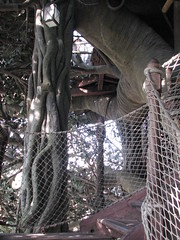 and go exploring, to try to see if you can possibly find every pathway, and then leave wondering if you somehow missed an entire corner. It’s a touch that seems distinctly European, a chance to discover things
and go exploring, to try to see if you can possibly find every pathway, and then leave wondering if you somehow missed an entire corner. It’s a touch that seems distinctly European, a chance to discover things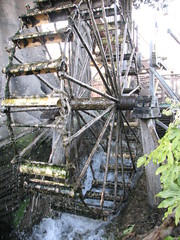 which one would never be able to point out on a map. Nearby is also La Cabane des Robinson, another entirely walk-through attraction, this one in an even more breathtaking setting (high up in a man-made tree overlooking the entire park) although this is sacrificed for a purely linear pathway route that doesn’t provide a chance to explore. Various sets are inspired by the Swiss Family Robinson story but unfortunately there’s never a completely clear vantage point from the top.
which one would never be able to point out on a map. Nearby is also La Cabane des Robinson, another entirely walk-through attraction, this one in an even more breathtaking setting (high up in a man-made tree overlooking the entire park) although this is sacrificed for a purely linear pathway route that doesn’t provide a chance to explore. Various sets are inspired by the Swiss Family Robinson story but unfortunately there’s never a completely clear vantage point from the top.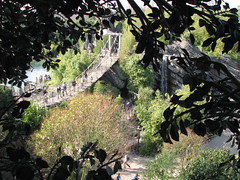 For me the main curiosity is figuring out how we’re supposed to believe that a family living in economic autarky could produce for themselves so many items of convenience. I suppose this does still leave Adventureland to be a little underdeveloped in comparison to the other lands, however, having a chance to fully explore this land I no longer believe this was wholly unintentional or due to neglect from the park’s Imagineers, not that an additional D- or C-ticket attraction wouldn’t be unwelcomed somewhere back by the pathway to Indiana Jones which currently forms an awkward cul-de-sac.
For me the main curiosity is figuring out how we’re supposed to believe that a family living in economic autarky could produce for themselves so many items of convenience. I suppose this does still leave Adventureland to be a little underdeveloped in comparison to the other lands, however, having a chance to fully explore this land I no longer believe this was wholly unintentional or due to neglect from the park’s Imagineers, not that an additional D- or C-ticket attraction wouldn’t be unwelcomed somewhere back by the pathway to Indiana Jones which currently forms an awkward cul-de-sac.
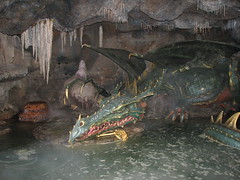 Looking over the guide to attractions I noticed something; many of the attractions listed were not even attractions but simply extensions of the main midways meant to explore without having to wait in line. Apparently there was an additional Aladdin walk-through I never saw, a barracks built over the entrance of Frontierland I did have the chance to climb over, the Nautilus attraction in Discoveryland I didn’t think too much of, and several built throughout Fantasyland, the principle of which was the ability to climb in and around Le Château de la Belle au Bois Dormant. Unfortunately since this was still technically the off-season, the majority of the castle was closed for renovations works and not open to the public to walk around, save for some of the caves built beneath it, one featuring a large, slumbering dragon
Looking over the guide to attractions I noticed something; many of the attractions listed were not even attractions but simply extensions of the main midways meant to explore without having to wait in line. Apparently there was an additional Aladdin walk-through I never saw, a barracks built over the entrance of Frontierland I did have the chance to climb over, the Nautilus attraction in Discoveryland I didn’t think too much of, and several built throughout Fantasyland, the principle of which was the ability to climb in and around Le Château de la Belle au Bois Dormant. Unfortunately since this was still technically the off-season, the majority of the castle was closed for renovations works and not open to the public to walk around, save for some of the caves built beneath it, one featuring a large, slumbering dragon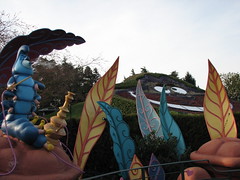 animatronic (thankfully the only other victims of off-season rehab during my visit was the Casey Jr. Train powered roller coaster, and honestly I had a hard time guessing where in the park it was even located that had to be closed off, as it’s sort of way back in its own corner of Fantasyland.) Also in Fantasyland was Alice’s Curious Labyrinth, a sort of hedge maze with interactive figures based on Alice in Wonderland, my favorite always being the smoking caterpillar. This is one walkthrough that, before entering, you need to calculate two things: will you have enough time to complete this before you need to use the restroom and before you need to be back at Big Thunder Mountain for (another) Fast Pass? I very nearly failed on both counts, such did the complexity of this labyrinth exceed my expectations.
animatronic (thankfully the only other victims of off-season rehab during my visit was the Casey Jr. Train powered roller coaster, and honestly I had a hard time guessing where in the park it was even located that had to be closed off, as it’s sort of way back in its own corner of Fantasyland.) Also in Fantasyland was Alice’s Curious Labyrinth, a sort of hedge maze with interactive figures based on Alice in Wonderland, my favorite always being the smoking caterpillar. This is one walkthrough that, before entering, you need to calculate two things: will you have enough time to complete this before you need to use the restroom and before you need to be back at Big Thunder Mountain for (another) Fast Pass? I very nearly failed on both counts, such did the complexity of this labyrinth exceed my expectations.
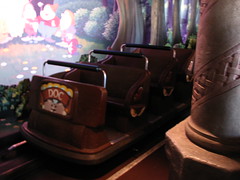 Before wrapping up any and all Fantasyland reporting, I must add a few notes on two more dark rides to be found in the area: Blanche-Neige et les Sept Nains (Snow White’s Scary Adventures), and Les Voyages de Pinocchio (Pinocchio’s Daring Journey). I liked these dark rides. They’re humble. That’s what makes them so great, unlike every other ride in the park where the Imagineers working on terra firma aimed for distant galaxies with their ambitions and the result is somewhere in between. They also remind me of the joy of watching one of the classic Disney animated films back when the company was still all about Walt’s dream of creating hand-drawn magic, and nothing else. The ride vehicles are simple, 6-person Sally-esque buggies that hum along an electric track past hand-painted scenes with simple 2D cutouts, retelling in five minutes the classic Disney movies of Snow White and Pinocchio.
Before wrapping up any and all Fantasyland reporting, I must add a few notes on two more dark rides to be found in the area: Blanche-Neige et les Sept Nains (Snow White’s Scary Adventures), and Les Voyages de Pinocchio (Pinocchio’s Daring Journey). I liked these dark rides. They’re humble. That’s what makes them so great, unlike every other ride in the park where the Imagineers working on terra firma aimed for distant galaxies with their ambitions and the result is somewhere in between. They also remind me of the joy of watching one of the classic Disney animated films back when the company was still all about Walt’s dream of creating hand-drawn magic, and nothing else. The ride vehicles are simple, 6-person Sally-esque buggies that hum along an electric track past hand-painted scenes with simple 2D cutouts, retelling in five minutes the classic Disney movies of Snow White and Pinocchio.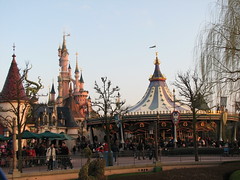 The queues aren’t long because they’re so out of the way, tucked in a small thatched of fantasy-Germanic buildings behind the Sleeping Beauty Castle. There are some happy sets, but also some scary, dark ones, which are effective not so much because of what is represented on the sets but through that aura associated with being on a simple dark ride such as these. Worth riding just because in their simplicity they are possibly two of the most authentically real feeling attractions in the park.
The queues aren’t long because they’re so out of the way, tucked in a small thatched of fantasy-Germanic buildings behind the Sleeping Beauty Castle. There are some happy sets, but also some scary, dark ones, which are effective not so much because of what is represented on the sets but through that aura associated with being on a simple dark ride such as these. Worth riding just because in their simplicity they are possibly two of the most authentically real feeling attractions in the park.
However, if there is one attraction in the park that I would return to Marne la Vallée just to ride, it would undoubtedly be Space Mountain: Mission 2. This thing flat-out rocks.
 The first time I boarded it two days prior in the front row, I knew only a few things to expect: there was a launched lift hill to the top of the mountain, there were three inversions, the last of which is called a ‘tongue’ and you want to be especially careful when that one rolls around (think of the cutback on the ill-fated Drachen Fire and you’ve got the same idea). It’s built by Vekoma, meaning it’s rough-as-hell, and no one that’s ever been on it has a clue what goes on inside between the launch and the brakes. As we were dispatched from the station, all I really knew was, “this could potentially go many different ways. Literally and figuratively”. When I got back to the station with my hair blown back, tears streaming behind my eyes and the quiet realization that I had just experienced one of the better steel looping coasters I’ve ever been on. Needless to say it went the way I was hoping, although I wasn’t sure why.
The first time I boarded it two days prior in the front row, I knew only a few things to expect: there was a launched lift hill to the top of the mountain, there were three inversions, the last of which is called a ‘tongue’ and you want to be especially careful when that one rolls around (think of the cutback on the ill-fated Drachen Fire and you’ve got the same idea). It’s built by Vekoma, meaning it’s rough-as-hell, and no one that’s ever been on it has a clue what goes on inside between the launch and the brakes. As we were dispatched from the station, all I really knew was, “this could potentially go many different ways. Literally and figuratively”. When I got back to the station with my hair blown back, tears streaming behind my eyes and the quiet realization that I had just experienced one of the better steel looping coasters I’ve ever been on. Needless to say it went the way I was hoping, although I wasn’t sure why.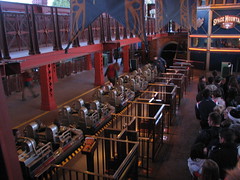
First of all, was it Vekoma rough? Not at all. Okay, back-axel seat rows, maybe a little bit; and more-so the further back in the train you get. If you’re in the back part of the car, it’s more a case of watching your knees on the seatback in front of you than worrying about an increased rattle which contributes to only a few jarring moments in some of the more dynamic transitions. During front row rides my ears never once made a connection with the harness due to any cause other than my own moral agency. It’s not too difficult getting front since there’s an attendant assigning seats but they’re pretty flexible towards requests to wait an extra cycle to grab the next train out.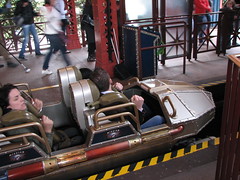
We roll around the turn, make a small dip under the exit platform, and then come to a sudden halt on the upward inclined brakes. For some reason, despite having made a transformation into Mission 2 a few years back, there are no special effects or decorations inside the launch cannon apart from a few simple strips of Christmas tree lights. The acceleration isn’t particularly fast but the g-forces are increased due to the slope. This is the only part of the ride in which you can see the outside world, at the top, it’s a plunge into blackness. I think there’s also supposed to be a pop of airtime on the crest to signify the weightlessness experienced upon our entry to space, but it wasn’t launching fast enough.
So far the coaster is only a few seconds in and there are already several critical counts against it. However, once we crest that hill and the beat from the soundtrack kicks in, the lead car hangs over the precipice of a black abyss for a split moment before diving downward, and here’s where the fun begins.
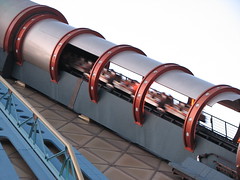 Honestly, I rode Space Mountain over 20 times between my three days at the Disneyland Resort, and even I can’t tell you exactly what’s going on in there, at least in a way in which I can picture the entire layout in my head. However, I did gather enough that I can at least describe a general sequence of events for those of you wanting to know but can’t see anything off the POVs (anyone know if there’s a lights-on POV video floating around teh interwebz anywhere?) Here’s my take on what happens: descending left-hand drop to ground level, continuing up around a high-speed banked turn, eventually leveling out for a moment before pounding into the first inversion, a sidewinder type element which pushes the limits of positives and forward inverting rotational movement through its tight circumference, and then throwing a sideways
Honestly, I rode Space Mountain over 20 times between my three days at the Disneyland Resort, and even I can’t tell you exactly what’s going on in there, at least in a way in which I can picture the entire layout in my head. However, I did gather enough that I can at least describe a general sequence of events for those of you wanting to know but can’t see anything off the POVs (anyone know if there’s a lights-on POV video floating around teh interwebz anywhere?) Here’s my take on what happens: descending left-hand drop to ground level, continuing up around a high-speed banked turn, eventually leveling out for a moment before pounding into the first inversion, a sidewinder type element which pushes the limits of positives and forward inverting rotational movement through its tight circumference, and then throwing a sideways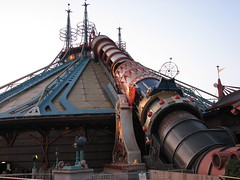 twist out of the maneuver. From here I recall another tighter, elevated turn or two before it slides onto the first midcourse. If there was any slowness in the launch, it certainly wasn’t to the detriment of the ride on the inside of the dome. The midcourse grabs hard, nearly bringing us to a halt, the soundtrack changing tempo to reflect this lost pace, but the fact that the music seems perfectly synced to our trains rolling off the midcourse back into the ride action suggests this heavy breaking may be intentional.
twist out of the maneuver. From here I recall another tighter, elevated turn or two before it slides onto the first midcourse. If there was any slowness in the launch, it certainly wasn’t to the detriment of the ride on the inside of the dome. The midcourse grabs hard, nearly bringing us to a halt, the soundtrack changing tempo to reflect this lost pace, but the fact that the music seems perfectly synced to our trains rolling off the midcourse back into the ride action suggests this heavy breaking may be intentional.
Off the midcourse brake there is a curving triple down in the dark. Wait, what? I thought the Voyage invented that? Apparently Disneyland Paris and Vekoma beat Holiday World and the Gravity Group to that one by a good eleven years. It actually took me a good four or five rides before I realized all those dips were continuous, and while it doesn’t produce any extreme forces itself, the sensual effect of diving down three times in a row while rounding a right-hand bend can feel a bit unusual by itself once you know to look for it. At the base of the triple down is the ride’s second inversion, a basic corkscrew threaded between a couple day-glo asteroids. It then wraps around a bit more before feeding
It actually took me a good four or five rides before I realized all those dips were continuous, and while it doesn’t produce any extreme forces itself, the sensual effect of diving down three times in a row while rounding a right-hand bend can feel a bit unusual by itself once you know to look for it. At the base of the triple down is the ride’s second inversion, a basic corkscrew threaded between a couple day-glo asteroids. It then wraps around a bit more before feeding into the second midcourse block, this one in the form of a minor lift hill (à la Loch Ness Monster’s midcourse lift), something else I was not expecting my first time through the ride. Projected on a screen in front of us as the motors work to quickly get us over the top is a short clip of a supernova going off, the soundtrack synced to produce rumbling sounds and the music score fades out before diving back to its frantic beat.
into the second midcourse block, this one in the form of a minor lift hill (à la Loch Ness Monster’s midcourse lift), something else I was not expecting my first time through the ride. Projected on a screen in front of us as the motors work to quickly get us over the top is a short clip of a supernova going off, the soundtrack synced to produce rumbling sounds and the music score fades out before diving back to its frantic beat.
Another diving curve, followed by, I think, a second banked turn (somewhere around here I was really wondering when that tongue I was warned about would happen, or if it had already gone by and I somehow hadn’t registered it). Bam, small dip and then we’re twisting up, upside-down, making a sudden and slightly unintuitive direction change right as we’re at our most precarious a full 180° turned away from gravity. The train rotates back out of the inversion, and then follows the floor of the mountain closely as it navigates a slightly undulating ground-level turn. While the dome has been rather sparse on custom themeing so far, a tunnel of spiraling red tracer light closes out this final turn, and the mindbending effect this produces makes me wish Disney decided to build this near a coffee shop in Amsterdam instead. The train plows into the braking area (viewable from the queue), and without even coming to a full stop it prowls around a couple flat turns as it navigates us back to our home port. At this point, if I was in the front seat, I was whipping the tears which had streamed from my eyes and fingering through my hair.
out of the inversion, and then follows the floor of the mountain closely as it navigates a slightly undulating ground-level turn. While the dome has been rather sparse on custom themeing so far, a tunnel of spiraling red tracer light closes out this final turn, and the mindbending effect this produces makes me wish Disney decided to build this near a coffee shop in Amsterdam instead. The train plows into the braking area (viewable from the queue), and without even coming to a full stop it prowls around a couple flat turns as it navigates us back to our home port. At this point, if I was in the front seat, I was whipping the tears which had streamed from my eyes and fingering through my hair.
Alright, so sounds like a pretty cool ride, right? Why do I give it such particular praise? Well, for one, I like the fact that this is a layout I have never seen before and has a completely non-standard sequencing pattern from every other multilooper. Things like the first inversion taking place later in the layout and not being a vertical loop, the triple down off the first midcourse, the cutback and effects tunnel, it all stands out above the competition as having an original bag of trick up its sleeve.
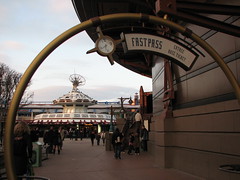 Secondly, it’s intense without ever being rough. Especially in the dark setting, it’s easy to get really disoriented in there, and apart from the crest of the main hill I never felt like any element was slower paced than it was intended to be. The era of construction may be a factor, as designers had figured out force engineering and calculus by that point to build layouts that didn’t hold back on pace or intensity for fear that they may unexpectedly go too far. But they still retained a bit of a raw, untamed edge which would eventually disappear from their designs, plus the standards of what constituted “too intense” hadn’t yet been lowered to the level they are today. So it also has all of that going for it, which is generally all I ask from a good looping coaster.
Secondly, it’s intense without ever being rough. Especially in the dark setting, it’s easy to get really disoriented in there, and apart from the crest of the main hill I never felt like any element was slower paced than it was intended to be. The era of construction may be a factor, as designers had figured out force engineering and calculus by that point to build layouts that didn’t hold back on pace or intensity for fear that they may unexpectedly go too far. But they still retained a bit of a raw, untamed edge which would eventually disappear from their designs, plus the standards of what constituted “too intense” hadn’t yet been lowered to the level they are today. So it also has all of that going for it, which is generally all I ask from a good looping coaster.
 But thirdly, and this is what really gave it the extra push over other like-minded designs and put it in the bottom of my Top Ten, is that it knows how to sequence itself properly, and it uses the let-ups in pacing to its advantage. While some designs pride themselves on no-holds-barred intensity from lift to brakes, Space Mountain is wise enough to strategically allow a couple moments’ pauses. They don’t come off as dead moments, but more like calms between storms (possibly aided by the soundtrack and visual effects which try to make these moments ‘fit’ with the rest of the action around it). I can always appreciate how much I enjoyed the previous section and how much I’m looking forward to the next, which is harder to do when the pacing is non-stop. The layout is divided into three thirds, and no one section outshines the others,
But thirdly, and this is what really gave it the extra push over other like-minded designs and put it in the bottom of my Top Ten, is that it knows how to sequence itself properly, and it uses the let-ups in pacing to its advantage. While some designs pride themselves on no-holds-barred intensity from lift to brakes, Space Mountain is wise enough to strategically allow a couple moments’ pauses. They don’t come off as dead moments, but more like calms between storms (possibly aided by the soundtrack and visual effects which try to make these moments ‘fit’ with the rest of the action around it). I can always appreciate how much I enjoyed the previous section and how much I’m looking forward to the next, which is harder to do when the pacing is non-stop. The layout is divided into three thirds, and no one section outshines the others,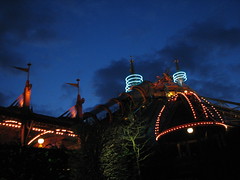 and yet they’re all very different and unique. Each has a singular, original inversion sandwiched by various forms of curving and or dropping motions with some scant special effects. And unlike Rock ‘n’ Roller Coaster next door, which is mostly just meandering turnarounds, here the layout feels like it’s actually setting out to accomplish something (anything!) for the riders.
and yet they’re all very different and unique. Each has a singular, original inversion sandwiched by various forms of curving and or dropping motions with some scant special effects. And unlike Rock ‘n’ Roller Coaster next door, which is mostly just meandering turnarounds, here the layout feels like it’s actually setting out to accomplish something (anything!) for the riders.
If there is one point of criticism I’d have to take with Space Mountain it’s the conception of outer space present here. This is actually true of nearly all themed attractions that involve space travel, as well as the majority of Hollywood movies and other media involving the final frontier. It’s the failure to realize that what makes space so awe-inspiring isn’t improved by the  ability to zoom past stars at “light speed” and hear a supernova explode just so you can fly away from it in the nick of time, nor is it using black holes as convenient teleportation devices or island hopping alien planets like you’re taking a drive down the neighborhood. What makes space so amazing is the inconceivably vast emptiness of it, the incredible inertia of the relatively microscopic heavenly bodies that occupy it, and the seemingly infinite quantities of time these bodies have at their disposal to get anything done. Why it is that popular culture feels these attributes need to be subverted rather than embraced is mystery only behind what shape the plane of the universe occupies. Personally, I always find these attempts to take space and make it more ‘exciting’ or ‘thrilling’ in fact just make it pedestrian and banal (the recent Star Trek reboot is only
ability to zoom past stars at “light speed” and hear a supernova explode just so you can fly away from it in the nick of time, nor is it using black holes as convenient teleportation devices or island hopping alien planets like you’re taking a drive down the neighborhood. What makes space so amazing is the inconceivably vast emptiness of it, the incredible inertia of the relatively microscopic heavenly bodies that occupy it, and the seemingly infinite quantities of time these bodies have at their disposal to get anything done. Why it is that popular culture feels these attributes need to be subverted rather than embraced is mystery only behind what shape the plane of the universe occupies. Personally, I always find these attempts to take space and make it more ‘exciting’ or ‘thrilling’ in fact just make it pedestrian and banal (the recent Star Trek reboot is only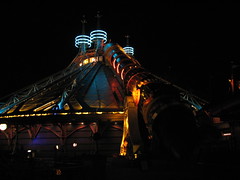 one of many suffering from this problem). Thankfully, DLP’s Space Mountain is a lesser offender since the retro-futuristic use of the Jules Verne story (and subsequent Georges Méliès film adaptation in 1902) gives the ride more of a historical, literary theme rather than one grounded in so-called science fiction. The transformation into Mission 2 was most likely not a step in the right direction, however, since from my understanding it replaced the iconic image of the spaceship landing in the moon’s eye with a supernova explosion, and –hello!– you can’t hear a supernova! I guess for a ride as fast-paced as Space Mountain an attempt to try to accurately capture those qualities of space would be misfit, so this is more of a general cultural criticism rather than anything to say about this particular attraction.
one of many suffering from this problem). Thankfully, DLP’s Space Mountain is a lesser offender since the retro-futuristic use of the Jules Verne story (and subsequent Georges Méliès film adaptation in 1902) gives the ride more of a historical, literary theme rather than one grounded in so-called science fiction. The transformation into Mission 2 was most likely not a step in the right direction, however, since from my understanding it replaced the iconic image of the spaceship landing in the moon’s eye with a supernova explosion, and –hello!– you can’t hear a supernova! I guess for a ride as fast-paced as Space Mountain an attempt to try to accurately capture those qualities of space would be misfit, so this is more of a general cultural criticism rather than anything to say about this particular attraction.
 After a final ride in the front row of Space Mountain, my time at Disney was now over. As I walked down Main Street USA, stopping in the emporium to pick up a cheap refrigerator magnet souvenir, I asked myself whether or not I enjoyed Disneyland Paris.
After a final ride in the front row of Space Mountain, my time at Disney was now over. As I walked down Main Street USA, stopping in the emporium to pick up a cheap refrigerator magnet souvenir, I asked myself whether or not I enjoyed Disneyland Paris.
Yes, I concluded. I genuinely did. While it might be easy to find criticism against the Disney Corporation as a whole, I think it’s clear that the people that work in and design these parks have a genuine love for what they do and for creating the best guest experience they possibly know how. While that might sound like an obvious observation, one look at other branches of the Disney Empire might not so quickly reveal the same thing, pretty much across the globe save for a certain studio in Emeryville, California. It was also more of a European experience than I may have imagined, taking some considerations of the continent’s culture and fitting it into the equation, rather than simply trying to export an American product to France with no 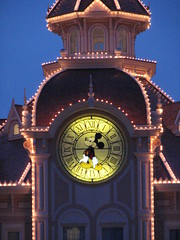 afterthought. Surprisingly, this would be more of a problem at many European-owned parks I would later travel to, which seemed to be attempting to replicate the American model of theme park as closely as they could only with less success.
afterthought. Surprisingly, this would be more of a problem at many European-owned parks I would later travel to, which seemed to be attempting to replicate the American model of theme park as closely as they could only with less success.
The story will not end there. Unfortunately I do not have enough time or patience to continue it with this review, but neither do I suspect most readers so I think it will be best to leave my final social and aesthetic critique of the “themed experience” for a later time and as its own special feature. To preface what’s to come: as I left the park my thoughts were as many enthusiasts, “wow, the themeing is some of the best I’ve seen anywhere.” But then a voice in the back of my head asked a follow-up question.
“So what?”
Comments